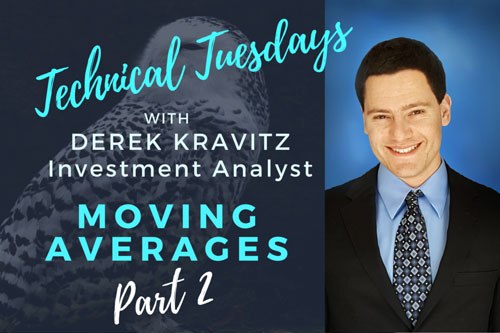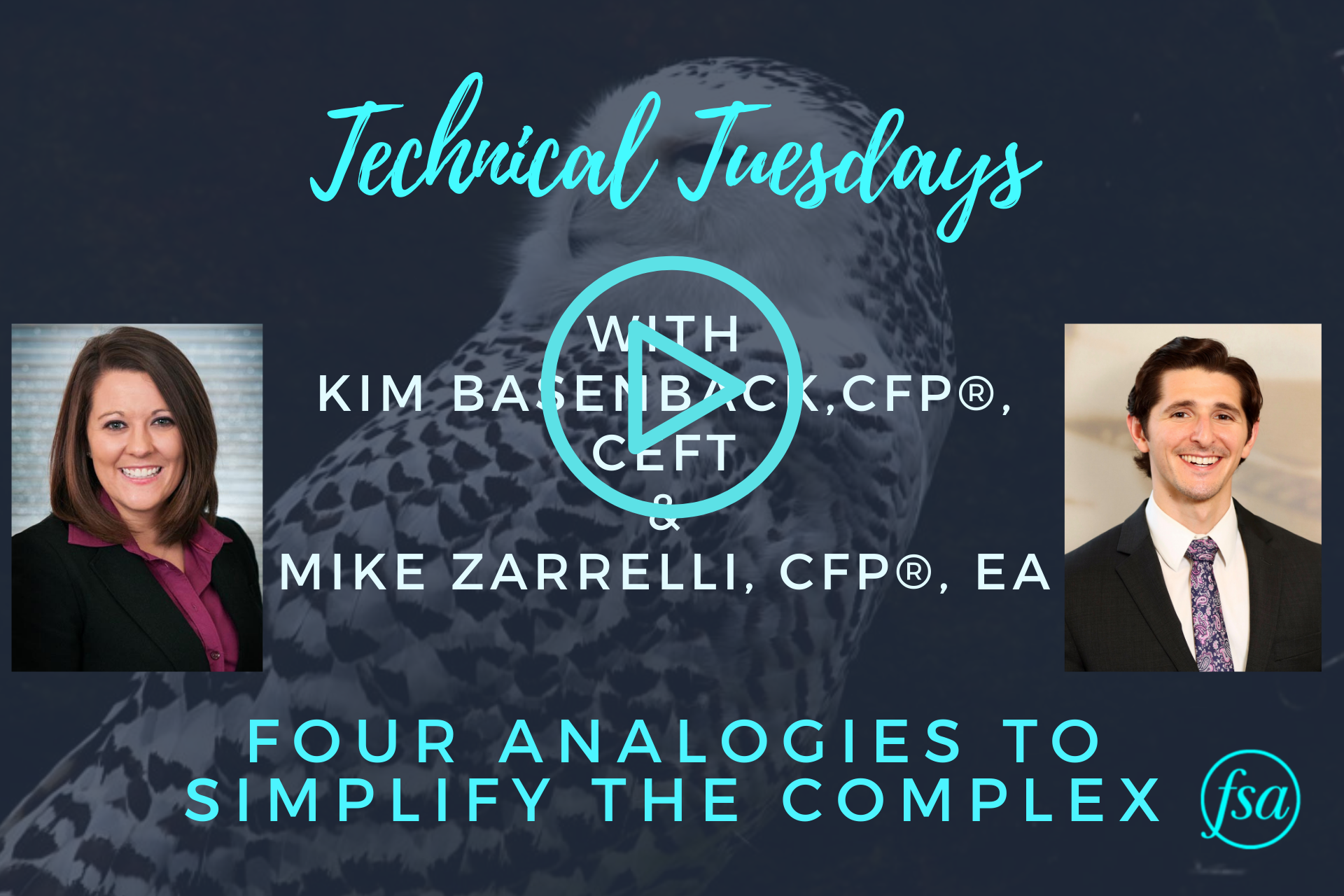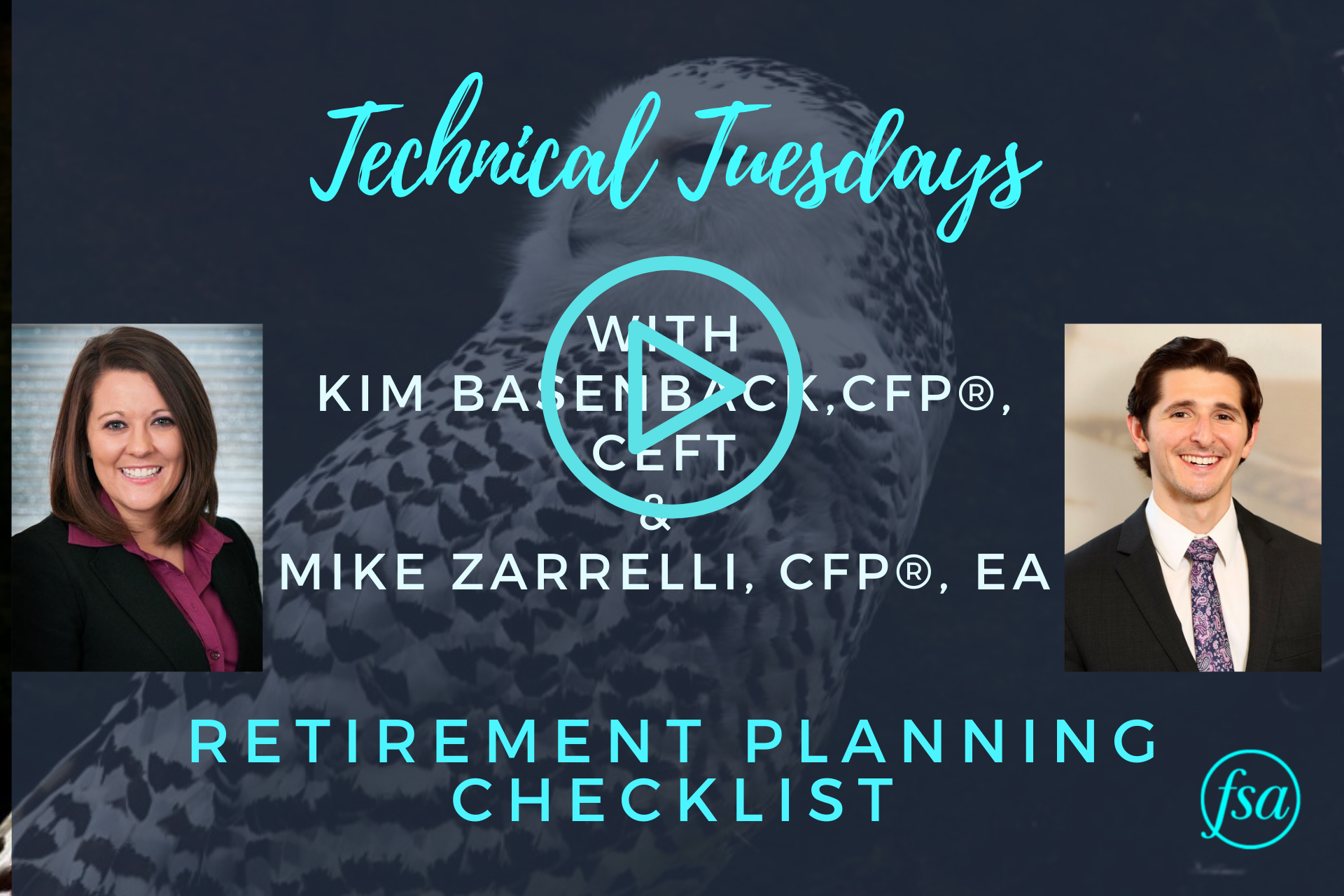In this Technical Tuesdays video, Derek continues his discussion on moving averages and how FSA uses them.
Moving Averages Part 2 Transcript
Hi, my name is Derek. I’m an investment analyst here at FSA. Today is Technical Tuesday, and we’re going to be going over moving averages. If you haven’t seen part one of Moving Averages, I would suggest watching it prior to this one. If you remember from our previous video, I had a lovely chart here graphing the prices of a particular security. For this video and for our purposes, we’re going to consider this the stock market. It’s having a great, great time here, and then suddenly it flattens out. We get some pullback, and then you gain momentum again, and it continues to go up.
So what does this mean for us and how do we make investment decisions using moving averages for this? Moving average looks at a certain amount of prior closing values. A shorter period moving average, one that looks at less values, is going to move faster than something that used a moving average that uses more closing values if the price of the underlying market or security is continuing to go up. In this case you have the market that’s steadily on an incline here, and the moving average is following it pretty much in line. When the market starts to peter out and even starts to go down, the moving average doesn’t respond immediately. Because it’s incorporating new values as well as the old positive values, it’s going to take a little bit longer before it starts to turn negative.
So what we do at FSA is we look at the market – say it’s the S&P 500, Dow, Nasdaq, anything. We’ll look at how the moving averages are, where they are in relation to where the market is. So if we have a market that is beginning to cross one of our critical moving averages, which is usually the 50, the 100, or the 150, looking at the past 50, 100, or 150 days, if we get a cross in there. maybe we start to lighten up because we say okay If the market is crossing these critical levels, there’s probably going to be ensued selling. The same is true once the market has finally decided to reach a bottom, such as it did in December of 2018, and once it starts rising again, once it rises past some of these critical levels such as, let’s call this moving average, we’ll just say it’s the last, you know, five closing prices here, once it crosses above those, as you can see here, we may even make a decision, okay, it’s time to start buying again. The market has shown us that the momentum has shifted in terms of being more positive again. Here’s where things get a little bit more interesting. If you have a slower period moving average, such as in this case, we’ll call it just a ten-period moving average, the lasts ten values, it’s going to move a little bit slower than the faster period, so you might get something that looks a little bit like this. So as you can see my lovely diagram here, it’s moving a little bit more slowly than the moving average that incorporates less values, and the reason is is because it’s it’s taking longer to catch up to this because it has much more data to look at than the faster period moving average. So that’s a knife that cuts both ways because on the way back down, sometimes you’ll get a market that may run into this and not break it because other traders and investors identify it as levels of support.
When we look at our charts, we’re not looking at just one moving average. We’re usually looking at a few. Some have much less data in them in terms of previous closing values, so the faster one is going to obviously be the one that the market breaches first when the market starts to go down, and we’ll look at the moving averages that incorporate many, many more data such as the 150 to see how the market reacts when it finally gets to there, the idea being that the greater amount of data in the moving average the stronger of a level of support and resistance, and this has been something that traders have paid attention to for centuries. Moving averages were actually first used by Japanese rice traders in the 16 hundreds. So this is something that the market pays a lot of attention to and we pay attention to because in certain instances we will see the market may breach one of our faster moving averages first. We might lighten up a little bit. It could be a sign to sell a little bit just in anticipation of potential further selling, but if it bounces off one of the larger moving averages, it could be a sign that, okay, it was just a little bit of a pullback in an otherwise healthy market. The alternative scenario is that instead of bouncing off this longer period moving average and continuing to go higher, we might get a price breach, and the market might continue to go down. That’s usually to us a sign that we need to take more seriously the possibility that the market will continue to fall and assess whether or not we need to sell more from there.
If you guys have any questions about this at any point, feel free to pick up the phone or give us an email. We’d be happy to talk more about it with you. This has been Technical Tuesday. My name is Derek. Thanks for joining us.
FSA’s current written Disclosure Brochure and Privacy Notice discussing our current advisory services and fees is available at www.FSAinvest.com/disclosures or by calling 301-949-7300.




